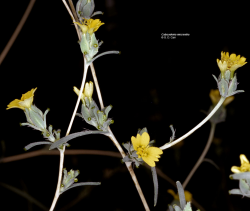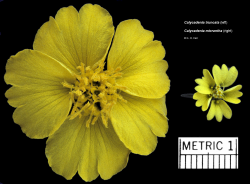
endangered
![Small-flowered calycadenia (Calycadenia micrantha): A - Habit, B - flower head, lateral view, C - flower head from above, D - peduncle bract (appressed to flower head, E - ray cypselae, F - peduncle bract tip with tack-shaped gland (from Holotype, R. L. Carr 3801 [UC]). Copyright © Gerald D. Carr from Calycadenia micrantha webpage (see References).](http://www.elkhornsloughctp.org/factsheet/images/1513301911cal_mic_plate.png)
Small-flowered calycadenia (Calycadenia micrantha): A - Habit, B - flower head, lateral view, C - flower head from above, D - peduncle bract (appressed to flower head, E - ray cypselae, F - peduncle bract tip with tack-shaped gland (from Holotype, R. L. Carr 3801 [UC]). Copyright © Gerald D. Carr from Calycadenia micrantha webpage (see References).

Small-flowered calycadenia (Calycadenia micrantha). Copyright © Gerald D. Carr from Calycadenia micrantha webpage (see References).

Comparison of flower heads of outcrossing Calycadenia truncata and self-compatible Calycadenia micrantha Copyright © Gerald D. Carr from Calycadenia micrantha webpage (see References).



This fact sheet was prepared by Dylan M. Neubauer under award NA04N0S4200074 from the National Oceanic and Atmospheric Administration (NOAA), U.S. Department of Commerce (DOC). The statements, findings, conclusions, and recommendations are those of the authors and do not necessarily reflect the views of the NOAA or the DOC.
© Copyright 2006, Elkhorn Slough Coastal Training Program
Last updated: Nov 21, 2017 19:27
Common Names - small-flowered calycadenia
Family - Asteraceae (Sunflower Family)
State Status - none
Federal Status - none
Habitat
Barren to sparsely vegetated areas with little competition, such as roadsides, dry ridges and slopes, and openings in chaparral, oak woodland, forest, meadows and seeps (volcanic), and annual grassland. Often in talus, scree, or gravel. In our region (Santa Cruz/Monterey/San Benito counties), small-flowered calycadenia generally occurs on serpentine substrates. 500–1500 m (Carr and Carr 2012, CNPS 2013, CNDDB 2017).
Key Characteristics
Self-compatible (2n = 14), aromatic, glabrous annual herb; stems to 5 dm tall, spreading to erect, slender, generally much-branched from middle, often purplish, glabrous; leaves basal and cauline, proximal leaves 2–5 cm long, cauline generally alternate, ± sessile, ± linear, reduced distally, proximal leaves generally hispidulous with sparse to dense, bristly hairs; flower head(s) 1(3) per node, peduncle bracts 2–4 mm long, with (0)1 terminal, tack-shaped gland; phyllaries 4–5 mm long, each partly enfolding a ray fruit; paleae in one series between ray and disk flowers, ± fused, forming a cup; ray flower(s) generally 1–3, ray 2–2.5(3.5) mm long, yellow, central lobe < lateral lobes, lateral lobes assymetric; disk flowers 1–3, corolla 3–4 mm long; ray cypselae wrinkled, glabrous, disk pappus 0 (Carr and Carr 2012).
Along with Calycadenia hooveri, C. spicata, C. truncata, and C. villosa, C. micrantha has generally 1 terminal, tack-like gland on each peduncle bract and the central ray lobe generally much shorter than the lateral lobes and widest at its base. Though very closely related to the most widespread species in the genus, C. truncata, morphologically similar C. micrantha differs from that taxon in its generally shorter stature (C. truncata ranges from 2–12 dm tall) and relatively slender stems (C. truncata can be robust), as well as its few-flowered heads (C. truncata has 3–25 disk flowers) and shorter rays (those of C. truncata measure 4–12 mm long) (Carr and Carr 2012). The two taxa have been observed growing sympatrically, though their growing seasons only partially overlap (Painter 1998).
Flowering Period
June to October
Global Distribution
This California endemic occurs in the North Coast Ranges (NCoR; high, inner, and outer) in Humboldt, Trinity, Colusa, Lake, and Napa counties, and, disjunctly, in the outer South Coast Ranges (SCoRO; Santa Lucia Range) in Monterey County.
Reference Population
South Coast Ridge Road, Los Padres National Forest boundary with Fort Hunter-Liggett (Monterey County).
Discussion
During the 1980s and 1990s, Robert L. Carr and Gerald D. Carr were made aware of several unique populations of plants “related to Calycadenia truncata” in Lake and southern Colusa counties. These plants were “shorter and more slender than most and had very tiny heads with only 1 or 2 obscure, tiny ray flowers and 1 or 2 disk flowers” (Carr and Carr 2004). In 2004, they described these plants as Calycadenia micrantha.
As the “heads and rays suggested the possibility of self-compatibility,” the Carrs conducted greenhouse studies with individuals from a number of populations. They concluded that “all individuals were self-compatible, a condition known to exist in only one other species of Calycadenia, C. hooveri G. D. Carr.” They also found that “although dozens of reciprocal crosses of these populations with self-incompatible forms of Calycadenia truncata [were] made, cypselae with embryos were generated only when the self-compatible form served as the female parent.” Carr (1975) observed the same pattern in C. hooveri, “and suggested that it may be the result of unilateral interspecific incompatibility, as discussed in Lewis and Crowe (1958).”
Their greenhouse studies led the Carrs to reexamine Calycadenia truncata DC. subsp. microcephala H. M. Hall, a taxon described by David D. Keck in 1946. Keck separated his subspecies from its closest relative “subsp. scabrella (Crew) Keck ... by the reduced number of disk florets ... and the smaller heads.” The Carrs examined specimens cited by Keck, along with others he had annotated, and found that though some did correspond with their new taxon, C. micrantha, others represented “populations of self-incompatible C. truncata plants with somewhat larger heads and rays.” Carr and Carr (2004) note that depauperate specimens, “especially those poorly pressed or without flowering heads at anthesis, could easily be confused” with C. micrantha.
Conservation and Threats
Monterey County contains only three of the 22 known occurrences, and these are located in two adjacent quads in the central Santa Lucia Range. Two of the three are located in the interface between U.S. Army–owned Fort Hunter Liggett and the Los Padres National Forest along and in the vicinity of the South Coast Ridge Road. The third occurrence lies to the east in Fort Hunter Liggett proper. All occurrences are in serpentine chaparral and serpentine barrens and in areas where C. truncata has also been collected, though their phenologies differ. As the area is quite rugged, more surveys are required to determine whether more populations exist.
Carr and Carr (2004) observe that “populations are generally small with few individuals,” and emphasize that the “species is surviving in an extremely limited and very fragile habitat.” Threats include road maintenance/off-road vehicles/dust/soil compaction; alteration of fire regimes and, potentially, controlled burns and fuel break construction; changes in hydrology; competition from non-native species; trampling from grazing animals and, potentially, feral pigs; and military activities (CNDDB 2017). In addition, small populations are vulnerable to random, stochastic events and climate change.
References
Baldwin, B. G. 1993. Phylogenetics of Calycadenia (Compositae) based on ITS sequences of nuclear ribosomal DNA: chromosomal and morphological evolution reexamined. American Journal of Botany 80(2):222–238.
California Native Plant Society (CNPS), Rare Plant Program. 2013. Calycadenia micrantha. Inventory of Rare and Endangered Plants (online edition, v8-03 0.39). California Native Plant Society, Sacramento, CA. http://www.rareplants.cnps.org/detail/2100.html [acc. 20 July 2017].
California Natural Diversity Database (CNDDB). 2017. [Internet]. California Department of Fish and Wildlife [acc. 13 November 2017].
Carr, G. D. 1975. Calycadenia hooveri (Asteraceae) a new tarweed from California. Brittonia 27:136–141.
Carr, G. D. 1977. A cytological conspectus of the genus Calycadenia (Asteraceae): an example of contrasting modes of evolution. American Journal of Botany 64:694–703.
G. D. Carr. 2006. Calycadenia micrantha R. L. Carr & G. D. Carr [webpage]. Calycadenia DC., in Systematics and evolution of the Madiinae: tarweeds to silverswords gallery of genera, University of Hawaii at Manoa, Department of Botany. http://www.botany.hawaii.edu/faculty/carr/cal_mic.htm [acc. 14 November 2017].
Carr, R. L. Carr and G. D. Carr. 2004. A new species of Calycadenia (Asteraceae) from north central California. SIDA, Contributions to Botany 21(1):259-265.
Carr, R. L. and G. D. Carr. 2006. Calycadenia micrantha, in Flora of North America Editorial Committee, (eds.) 1993+. Flora of North America North of Mexico. 19+ vols. New York and Oxford. Vol. 21. http://www.efloras.org/florataxon.aspx?flora_id=1&taxon_id=250066277 [acc. 13 November 2017].
Carr, R. L. Carr and G. D. Carr. 2012. Calycadenia micrantha, in Jepson Flora Project (eds.) Jepson eFlora, http://ucjeps.berkeley.edu/eflora/eflora_display.php?tid=81268 [acc. 20 July 2017].
Keck, D. D. 1946. A new subspecies of Calycadenia truncata from the Coast Ranges of California. Leaflets of Western Botany 4:259–260.
Lewis, D. and L. K. Crowe. 1958. Unilateral interspecific incompatibility in flowering plants. Heredity 12:233–256.
Matthews, M. A. and M. Mitchell. 2015. The plants of Monterey County: an illustrated field key, Second Edition. Monterey Bay Chapter, California Native Plant Society, Carmel, CA.
Painter, E. 1998. CNDDB form, Calycadenia micrantha.
